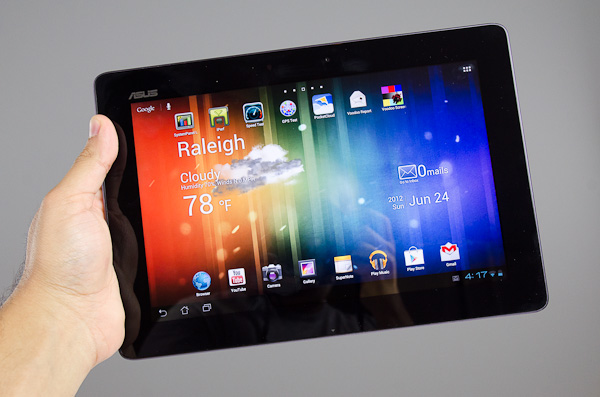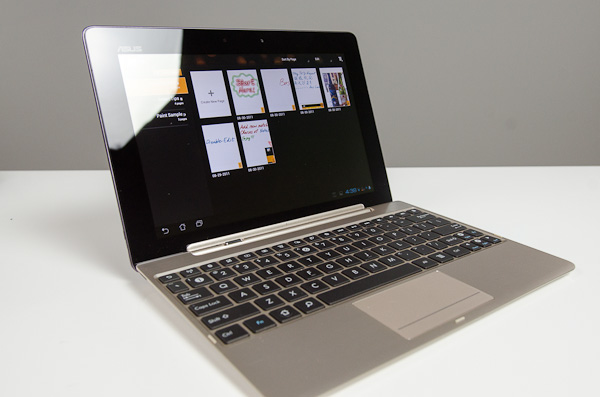ASUS Transformer Pad Infinity (TF700T) Review
by Anand Lal Shimpi on June 25, 2012 3:00 AM ESTAt Computex a few weeks ago ASUS gave us exactly what we had been hoping for: a Transformer-style tablet running Windows 8. In fact, ASUS gave us a bunch of options as far as Windows 8 tablets go. The two we've been asking for are the Tablet 600 and Tablet 810, running Windows RT and Windows 8, respectively. They feature standalone tablets with detachable keyboard/mouse docks, giving you the best of both worlds.
ASUS wasn't the only one to bring this sort of flexibility to Windows 8. Acer showed off a similar design with its Iconia W510, as did Samsung and more recently, Microsoft. With the Surface tablets Microsoft actually went a step further and tried to integrate the keyboard into a lightweight cover rather than an external dock. It remains to be seen just how well these approaches will work, but it's clear there's a trend for the first generation of Windows 8 tablets.
We can't forget however what started this all. Much like Apple with the iPhone and iPad, ASUS picked an intersection of functionality and technical feasibility with the introduction of the first Eee Pad Transformer. For the first time we had silicon capable of running for hours in a small form factor tablet, as well as a touch-enabled OS that could run on it. Previous attempts at hybrid tablets often tried to shoehorn a desktop version of Windows into a device that was too clumsy. ASUS' Transformer series was the start of something new.
Since the release of the first Eee Pad Transformer (can you believe it's only been about a year?), ASUS has released several members of the Eee Pad and Transformer families. We got a slider, a thinner version called the Transformer Prime, as well as a refreshed entry level Transformer Pad 300. ASUS' experimentation and learning will pay off later this year as it ships the first Windows RT/8 versions. Until then however ASUS isn't done iterating. Today it's officially announcing the final configuration of the Transformer Pad Infinity, the first member of the TF series with a 1920 x 1200 display. It also happens to be the first tablet we've tested to use NVIDIA's higher binned Tegra 3 T33 SoC.
| ASUS Tablet Specification Comparison | ||||||
| ASUS Eee Pad Transformer | ASUS Transformer Pad 300 Series | ASUS Eee Pad Transformer Prime | ASUS Transformer Pad Infinity | |||
| Dimensions | 271mm x 175mm x 12.95mm | 263 x 180.8 x 9.9mm | 263 x 180.8 x 8.3mm | 263 x 180.6 x 8.4mm | ||
| Chassis | Plastic | Plastic | Aluminum | Aluminum + Plastic RF Strip | ||
| Display | 10.1-inch 1280 x 800 | 10.1-inch 1280 x 800 IPS | 10.1-inch 1280 x 800 Super IPS+ | 10.1-inch 1920 x 1200 Super IPS+ | ||
| Weight | 675g | 635g | 586g | 594g | ||
| Processor | 1GHz NVIDIA Tegra 2 (2 x Cortex A9) |
NVIDIA Tegra 3 (T30L - 4 x Cortex A9) |
1.3GHz NVIDIA Tegra 3 (T30 - 4 x Cortex A9) |
1.6GHz NVIDIA Tegra 3 (T33 - 4 x Cortex A9) |
||
| Memory | 1GB | 1GB | 1GB | 1GB DDR3-1600 | ||
| Storage | 16GB + microSD card | 16GB/32GB | 32GB/64GB + microSD slot | 32/64GB + microSD slot | ||
| Battery | 24.4Whr | 22Whr | 25Whr | 25Whr | ||
| Pricing | $399 | $379/$399 | $499/$599 | $499/$599 | ||
Despite early indications of $599+ pricing, the Transformer Pad Infinity comes in at $499 for the 32GB model and $599 for 64GB. The Infinity is compatible with the Transformer Dock ($149) from the TF Prime as long as your dock has firmware 207 or later on it. The dock is what gives the Transformer Pad its name as it allows the Infinity to be converted into an Android netbook complete with QWERTY keyboard, trackpad and additional battery. The Infinity and its dock are available in the same two colors (amethyst gray and champagne gold) as the TF Prime was at launch. The Infinity dock doesn't appear to carry a separate part number, it's literally the same dock that was used with the Prime.
The chassis hasn't changed much since the introduction of the Prime. It is one-tenth of a millimeter thicker to accommodate the higher-resolution display and backlight assembly, but battery capacity remains at 25Wh. The Infinity is a little heavier and its edges are squared a bit instead of being perfectly rounded. The port configuration remains the same (micro HDMI, micro SD, headphone jack), although redistributed around the chassis. The power and volume buttons are now both located along the top of the unit, with the switches themselves more integrated with the tablet.
Although official reviews of the Infinity hit today, availability isn't scheduled until around July 16th. Quantities are unknown at this point and will likely be gated by panel availability.



















112 Comments
View All Comments
Tchamber - Monday, June 25, 2012 - link
I had problems browsing with the ipad, too. The difference is that on my TFP the browser rights itself rather than having to close it and open again. Multitasking is easier too, no double tapping anything. Sure ICS could be polished up a bit, but as far as capability its at least on par with IOS. IPad still has performance edge and battery, but thats getting smaller all the time.sawilson - Monday, June 25, 2012 - link
iOS is a lot less stable than ICS. You don't have to take my world for it. Crittercism did the research. Safari is the buggiest piece of sh*t I've used in my life on iOS, and it's a damn shame because it's one of the finest browsers I've used when on OSX. It's shame apple can't just get OSX working on the ipad. Then it would be worth it.DeciusStrabo - Tuesday, June 26, 2012 - link
I would say they are about the same for me. Maybe, maybe Android is a bit more stable, but I would attribute this to the fine gentlemen and -women working at CM9. Neither is annoying with the crashes, so I'd say they are both perfectly usable.sprockkets - Monday, June 25, 2012 - link
Put Chrome on it - for whatever reason the browser on Asus' tablets is not up to par. Why when every other ICS browser works fine is beyond me...Belard - Tuesday, June 26, 2012 - link
Get OPERA for Android then... much better than the built in browser.Belard - Tuesday, June 26, 2012 - link
OOPS! Even for my Samsung galaxy phone, the Opera browser is excellent. I get tabbed browsing, better entry for text fields.lilmoe - Monday, June 25, 2012 - link
I actually HATE Apple products myself. But Anand is anything but a fanboy... I know a fanboy when i see one. Engadget, TB, and other websites "tech websites" have lots of them.Anyway. While I seriously hate admitting this. "Currently", the only tablet worth buying if the user is concerned about "user experience" and fluidity is in fact the iPad. I personally think the iPad 2,4 is the best deal out there; i could care less for higher "non-standard" resolutions.
But Anand threw a bomb at the end of his article here. The transformer line needs a much more fluid and "functional" OS. That being, Windows 8. I agree. Windows 8 ARM/x86 tablets are going to show us a whole new dimension in computing and fluidity. Be prepared to see most Anandtech authors being called Windows/Microsoft fanboys by the end of the year.
BabelHuber - Monday, June 25, 2012 - link
AFAIK Windows 8 RT is locked, like the iPad is.This means e.g. no sideloading of Apps, you have to rely on Microsoft's App store.
I even haven't rooted my TF Prime since I haven't seen a need so far.
Of course you can jailbreak the iPad, probably you will be able to do so with Windows RT devices. BUT what disadvantages do you get? On Android I have none, except of voiding my warranty.
The TF series consists of real PCs, meaning that PERSONAL is a part of it since I can do whatever I see fit with my device.
A part of this are standard interfaces like HDMI, SD cards and USB. I wouldn't want to miss this.
So the bottom line is: Until I haven't seen detailled tests of WIndows RT tablets, it remains to be seen whether Windows RT will be 'better' at all.
As a sindenote: WIth WIndows Surface, MS is directly competing with its OEMs. It remains to be seen how OEMs will react.
Samsung and HTC already made it clear that they prefer Android over WIndows Phone for smartphones. The tablet race is still open, Microsoft has no user base whatsoever.
xype - Monday, June 25, 2012 - link
The thing is that tablets for most people are appliances. The group that actually wants a PC in a tablet form factor is not that large. The group that couldn’t care less as long as they don’t have to spend time tinkering with the device is much, much larger.Of course an argument can be made that iOS can be jailbroken (and Windows RT will probably be, too), and there certainly is a group of people out there who prefers an Apple device with the "openess" they expect from a PC.
And that’s all ok! Android is a perfect fit for the "tinkerers" and thanks to Apple setting expectations pretty high, they’ll get a great tablet/phone user experience to boot, as Android needs to stay competitive with iOS. It’s like the mythical "Linux on the Desktop", but with more apps. :oP
Windows 8/RT’s impact remains to be seen. Their approach certainly is novel and if Microsoft can manage to get enough developers on board, they might end up with a real alternative. I’m only afraid they will end up being too schizophrenic for that, trying to do it all and ending up doing nothing well enough for people to give a shit.
BabelHuber - Monday, June 25, 2012 - link
I did not talk about 'tinkering'. Tinkering for me means installing Custom ROMs, overclocking, replacing system files etc.Everybody who is able to download a program for Windows/ OS X and install it can do this also with Android.
No need for rooting, no need for tinkering. Just downloading a file, going to the file browser and selecting the downloaded file is very easy.
If an OS does not provide this, it is not a full OS, but a restricted one.